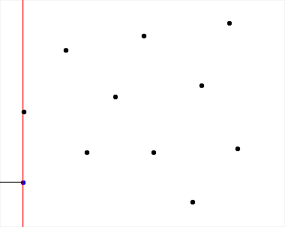Top Qs
Timeline
Chat
Perspective
Fortune's algorithm
Voronoi diagram generation algorithm From Wikipedia, the free encyclopedia
Remove ads
Fortune's algorithm is a sweep line algorithm for generating a Voronoi diagram from a set of points in a plane using O(n log n) time and O(n) space.[1][2] It was originally published by Steven Fortune in 1986 in his paper "A sweepline algorithm for Voronoi diagrams."[3]

Algorithm description
Summarize
Perspective
The algorithm maintains both a sweep line and a beach line, which both move through the plane as the algorithm progresses. The sweep line is a straight line, which we may by convention assume to be vertical and moving left to right across the plane. At any time during the algorithm, the input points left of the sweep line will have been incorporated into the Voronoi diagram, while the points right of the sweep line will not have been considered yet. The beach line is not a straight line, but a complicated, piecewise curve to the left of the sweep line, composed of pieces of parabolas; it divides the portion of the plane within which the Voronoi diagram can be known, regardless of what other points might be right of the sweep line, from the rest of the plane. For each point left of the sweep line, one can define a parabola of points equidistant from that point and from the sweep line; the beach line is the boundary of the union of these parabolas. As the sweep line progresses, the vertices of the beach line, at which two parabolas cross, trace out the edges of the Voronoi diagram. The beach line progresses by keeping each parabola base exactly halfway between the points initially swept over with the sweep line, and the new position of the sweep line. Mathematically, this means each parabola is formed by using the sweep line as the directrix and the input point as the focus.
The algorithm maintains as data structures a binary search tree describing the combinatorial structure of the beach line, and a priority queue listing potential future events that could change the beach line structure. These events include the addition of another parabola to the beach line (when the sweep line crosses another input point) and the removal of a curve from the beach line (when the sweep line becomes tangent to a circle through some three input points whose parabolas form consecutive segments of the beach line). Each such event may be prioritized by the x-coordinate of the sweep line at the point the event occurs. The algorithm itself then consists of repeatedly removing the next event from the priority queue, finding the changes the event causes in the beach line, and updating the data structures.
As there are O(n) events to process (each being associated with some feature of the Voronoi diagram) and O(log n) time to process an event (each consisting of a constant number of binary search tree and priority queue operations) the total time is O(n log n).
Pseudocode
Pseudocode description of the algorithm.[4]
let be the transformation , where is the Euclidean distance between z and the nearest site let T be the "beach line" let be the region covered by site p. let be the boundary ray between sites p and q. let be a set of sites on which this algorithm is to be applied. let be the sites extracted from S with minimal y-coordinate, ordered by x-coordinate let DeleteMin(X) be the act of removing the lowest and leftmost site of X (sort by y unless they're identical, in which case sort by x) let V be the Voronoi map of S which is to be constructed by this algorithm create initial vertical boundary rays while not IsEmpty(Q) do p ← DeleteMin(Q) case p of p is a site in : find the occurrence of a region in T containing p, bracketed by on the left and on the right create new boundary rays and with bases p replace with in T delete from Q any intersection between and insert into Q any intersection between and insert into Q any intersection between and p is a Voronoi vertex in : let p be the intersection of on the left and on the right let be the left neighbor of and let be the right neighbor of in T if , create a new boundary ray else if p is right of the higher of q and s, create else create endif replace with newly created in T delete from Q any intersection between and delete from Q any intersection between and insert into Q any intersection between and insert into Q any intersection between and record p as the summit of and and the base of output the boundary segments and endcase endwhile output the remaining boundary rays in T
Remove ads
Weighted sites and disks
Additively weighted sites
As Fortune describes in ref.,[1] a modified version of the sweep line algorithm can be used to construct an additively weighted Voronoi diagram, in which the distance to each site is offset by the weight of the site; this may equivalently be viewed as a Voronoi diagram of a set of disks, centered at the sites with radius equal to the weight of the site. the algorithm is found to have time complexity with n being the number of sites according to ref.[1]
Weighted sites may be used to control the areas of the Voronoi cells when using Voronoi diagrams to construct treemaps. In an additively weighted Voronoi diagram, the bisector between sites is in general a hyperbola, in contrast to unweighted Voronoi diagrams and power diagrams of disks for which it is a straight line.
Remove ads
References
External links
Wikiwand - on
Seamless Wikipedia browsing. On steroids.
Remove ads



























